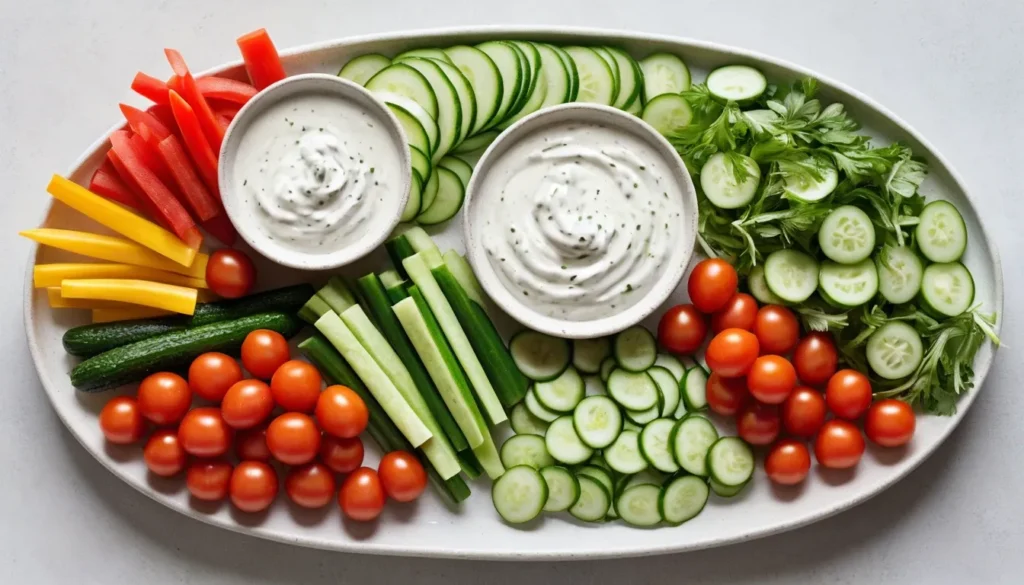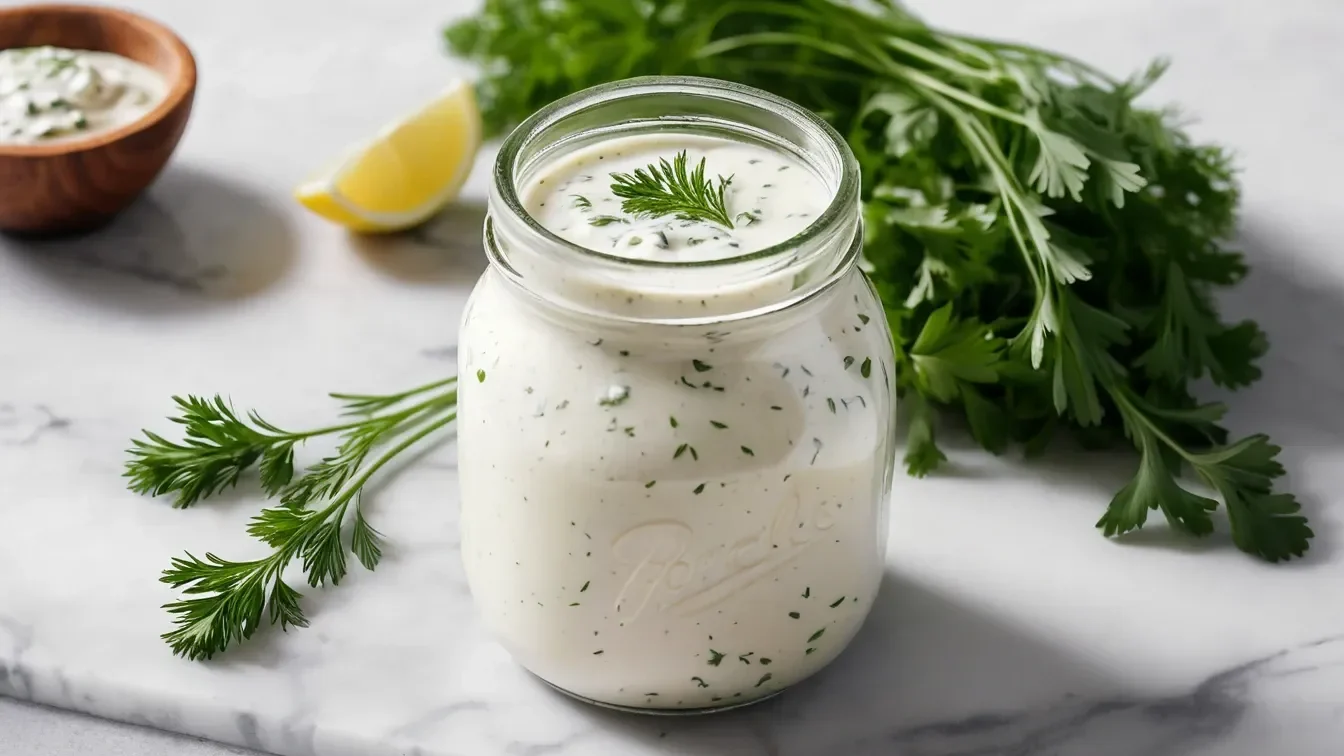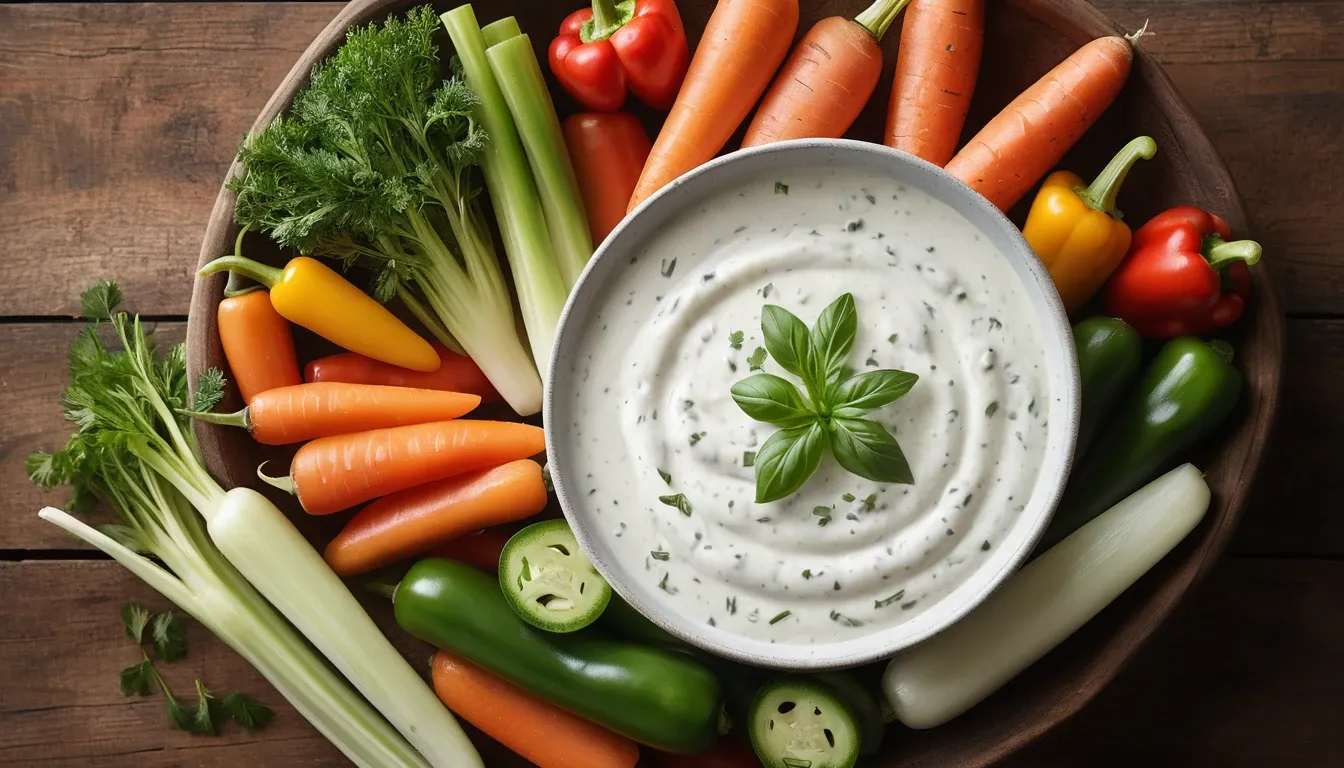Table of Contents
How many calories are in Outback ranch dressing? Outback Steakhouse is famous for its flavorful dishes and irresistible sides. One of my favorites is its ranch dressing. It’s a rich and delicious choice for salads or dips. What are the calories contained in Outback ranch dressing? Knowing its calories and nutritional data will help diners make educated and conscious decisions.
We’ll discuss the calories in Outback ranch dressing. We’ll also look at its ingredient list and the nutritional significance.
We’ll also discuss tips for enjoying it responsibly and explore healthier alternatives for those looking to cut calories while enjoying a flavorful experience.
Understanding Outback Ranch Dressing
What Is Ranch Dressing?
Ranch dressing is one of the most popular condiments in American cuisine, prized for its creamy, tangy flavour. It is typically made with a base of mayonnaise and buttermilk combined with herbs and spices like dill, parsley, and garlic powder. Its versatility makes it a favourite for salads, dips, and topping for dishes like fries or chicken wings.
Outback Steakhouse’s ranch dressing stands out because of its rich texture and well-balanced taste. The recipe is crafted to pair perfectly with their menu offerings, including the signature Bloomin’ Onion and fresh salads.
For those interested in recreating the flavours at home, check out this Outback Ranch Recipe, which brings the steakhouse experience to your kitchen.
Ingredients in Outback Ranch Dressing
The calorie count and nutritional profile of Outback ranch dressing stem from its ingredients, which typically include:
- Base Ingredients:Mayonnaise: Adds creaminess but is calorie-dense due to its high fat content.
- Buttermilk: Contributes a tangy flavour and smooth consistency while adding some calories.
- Sour Cream: Provides richness and a slightly tangy taste.
- Herbs and Spices: Common flavour enhancers like garlic powder, onion powder, dill, parsley, and chives.
- Seasonings: Salt, black pepper, and sugar help balance the flavours and add depth.
While the precise recipe is a closely guarded secret, these ingredients are common in many restaurant-style ranch dressings. Outback’s version is known for its slightly thicker consistency, making it ideal as a dip or salad dressing.
Why People Love Outback Ranch Dressing
Outback’s ranch dressing is beloved for its:
- Creaminess: The smooth, velvety texture enhances every bite.
- Balanced Flavor: The tangy, savoury, and slightly sweet notes make it universally appealing.
- Versatility: Perfect as a dressing, dip, or sauce.
Understanding the ingredients and why it’s so popular sets the stage for exploring its calorie content and how to incorporate it into your diet responsibly.
Calorie Content of Outback Ranch Dressing

How Many Calories Are in Outback Ranch Dressing?
The calorie content of Outback ranch dressing varies depending on the serving size. A typical serving of 2 tablespoons (30g) contains approximately 140-150 calories, but this number can fluctuate slightly based on the specific recipe Outback Steakhouse uses.
The calorie count can quickly add up for more significant portions, such as those used for dipping appetizers or drenching salads. For example:
- 1 tablespoon (15g): ~70-75 calories.
- 2 tablespoons (30g): ~140-150 calories.
- 4 tablespoons (60g): ~280-300 calories.
Comparing Outback Ranch Dressing to Other Dressings
Outback ranch dressing tends to have a similar calorie count to other full-fat, restaurant-style ranch dressings. This is how it compares to other top choices:
- Classic Ranch Dressing (store-bought): ~130-150 calories per 2 tablespoons.
- Caesar Dressing: ~150-160 calories per 2 tablespoons.
- Italian Dressing (oil-based): ~80-90 calories per 2 tablespoons.
- Low-Fat Ranch Dressing: ~60-80 calories per 2 tablespoons.
As you can see, Outback ranch dressing is comparable to other full-fat options but higher in calories than oil-based or low-fat alternatives.
Factors That Contribute to Its Calorie Content
Several factors make Outback ranch dressing calorie-dense:
- High-Fat Content: Ingredients like mayonnaise, buttermilk, and sour cream are calorie-rich, with fat being the primary contributor.
- Portion Size: Restaurant servings are often more generous than recommended portions, which can double or triple calorie intake.
- Sugar and Salt: Though present in small amounts, these ingredients contribute additional calories.
Hidden Calories in Dipping and Dressing
While ranch dressing may seem like a small addition, its calorie count can become significant when used liberally:
- Dipping Fries or Onion Rings: Dipping each piece can consume 4-6 tablespoons of dressing (~300-450 calories).
- Topping Salads: Using more than the recommended 2-tablespoon serving can turn a healthy salad into a high-calorie meal.
Understanding these calorie numbers helps diners make more informed choices when indulging in Outback’s flavorful ranch dressing.
Nutritional Profile of Outback Ranch Dressing

Macronutrient Breakdown
Outback ranch dressing is a calorie-dense condiment due to its macronutrient composition. Here’s a typical breakdown for a 2-tablespoon (30g) serving:
- Calories: ~140-150
- Fat: ~14-16gSaturated Fat: ~2-3g
- Carbohydrates: ~2-3gSugars: ~1g
- Protein: ~1g
Are you curious about how ranch compares to other dressings like blue cheese? You can also explore how dressings differ in flavour and nutrition by visiting the Steakhouse Blue Cheese Dressing Recipe guide.
Fats in Outback Ranch Dressing
The high-fat content, primarily from mayonnaise and buttermilk, primarily contributes to its calorie count. While fats are necessary for energy and nutrient absorption, excessive intake, particularly of saturated fats, can impact heart health.
Carbohydrates and Sugars
Outback ranch dressing has a relatively low carbohydrate content, making it suitable for low-carb or keto diets. However, it contains a small amount of sugar, likely added to enhance flavour balance.
Protein Content
With just about 1 gram of protein per serving, Outback ranch dressing isn’t a significant source of this macronutrient. It’s primarily a fat-based dressing with minimal protein contributions.
Sodium Content
A 2-tablespoon serving contains approximately 270-300mg of sodium, about 12-13% of the recommended daily intake. Excessive sodium intake can lead to water retention and higher blood pressure, so it’s worth monitoring portion sizes if you’re watching your salt intake.
Micronutrients
Outback ranch dressing offers minimal amounts of vitamins and minerals, though it may contain small traces of:
- Calcium: From buttermilk or sour cream.
- Vitamin A: From the herbs and spices used.
These amounts are typically not significant enough to contribute meaningfully to daily nutritional needs.
Is Outback Ranch Dressing Keto-Friendly?
Yes, Outback ranch dressing is considered keto-friendly because of its high-fat, low-carb profile. Only 2-3g of carbohydrates per serving can fit nicely into a ketogenic diet, provided portion sizes are controlled.
For keto-friendly pairings, try it with a side of grilled veggies or protein-packed salads, like this Outback House Salad.
Balancing Nutritional Intake
To balance your intake when consuming ranch dressing:
- Opt for smaller portions to minimize calorie and fat intake.
- Pair it with low-calorie, nutrient-dense foods like fresh vegetables.
- You can use it to enhance the flavour rather than the principal ingredient of the dish.
This understanding of the nutritional profile equips diners with the knowledge to enjoy Outback ranch dressing in moderation while maintaining their dietary goals.
Ways to Enjoy Outback Ranch Dressing Responsibly
Portion Control Is Key
One of the simplest ways to enjoy Outback ranch dressing without overindulging calories is by practising portion control. Since a standard serving size of 2 tablespoons contains about 140-150 calories, sticking to this portion can help you enjoy the flavour without exceeding your daily caloric goals.
If you’re looking for more low-calorie dipping options, check out what Ketchup and Ranch Make for a fun alternative to traditional ranch.
Tips for Portion Control:
- Measure Your Serving: Use a spoon to ensure you do not exceed the recommended amount.
- Dip Strategically: Dip only a tiny part of your food instead of coating it entirely.
- Request Dressing on the Side: When dining at Outback Steakhouse, ask for your ranch dressing on the side to control how much you use.
Pair with Healthy Options
Ranch dressing pairs well with fresh, nutrient-dense foods, allowing you to enjoy its flavour while balancing your meal’s nutritional value.
Healthy Pairing Ideas:
- Vegetable Sticks: Use ranch as a dip for carrots, celery, cucumbers, or bell peppers.
- Salads with Lean Proteins: Top your salad with grilled chicken, turkey, or shrimp, and drizzle a small amount of ranch dressing for flavour.
- Roasted Vegetables: A drizzle of ranch dressing can enhance the taste of roasted broccoli, cauliflower, or zucchini.
Make Health-Conscious Modifications
If dining at Outback Steakhouse, consider modifying your order to minimize calorie intake while enjoying ranch dressing.
Suggestions for Healthier Choices:
- Ask for Light Dressing: Some locations may offer a lighter version of their ranch dressing upon request.
- Dilute the Dressing: Mix a small amount of ranch with water, lemon juice, or low-fat yoghurt for a thinner, lower-calorie dressing.
- Limit Add-Ons: Avoid pairing ranch dressing with calorie-heavy options like cheese, croutons, or fried foods.
Use Ranch as a Flavor Enhancer, Not the Star
Instead of relying on the ranch as the main ingredient in your dish, use it sparingly to enhance the overall flavour. For instance:
- Drizzle a small amount over a salad instead of mixing it thoroughly.
- Use ranch dressing as a dip for a few appetizer bites rather than for the entire meal.
Keep Track of Your Overall Calorie Intake
When enjoying indulgent items like ranch dressing, monitoring your overall calorie intake for the day is essential. Balancing high-calorie condiments with lighter meals or snacks can help you maintain your dietary goals.
Why Moderation Matters
Ranch dressing is delicious but calorie-dense, and overindulgence can lead to consuming hundreds of extra calories without realizing it. Using the above strategies, you can savour the taste of Outback ranch dressing without derailing your health goals.
Healthier Alternatives to Ranch Dressing
Opt for Low-Fat or Light Ranch Options
Many restaurants and grocery stores offer reduced-fat or “light” ranch dressings with fewer calories and less fat than the traditional version. These can provide a similar flavour profile while more suitable for calorie-conscious individuals.
Are you looking to expand your salad dressing repertoire? Try a tangy twist with this Cajun Alfredo Sauce Recipe for a unique, spicy dressing.
Examples of Lighter Alternatives:
- Low-Fat Ranch Dressing: Contains around 60-80 calories per 2 tablespoons.
- Greek Yogurt Ranch Dressing: Greek yoghurt is used as a base, offering fewer calories and more protein.
- Vegan Ranch: Typically made with plant-based ingredients, these options may have fewer saturated fats.
Make Your Healthy Ranch Dressing
Creating ranch dressing at home allows you to control the ingredients and customize the flavour. Here’s a simple, healthier recipe:
- Ingredients:½ cup plain Greek yogurt
- 2 tablespoons low-fat buttermilk
- 1 teaspoon garlic powder
- 1 teaspoon onion powder
- 1 teaspoon dried dill
- Salt and pepper to taste
- Directions: Mix all ingredients thoroughly and refrigerate for at least 30 minutes to let the flavours meld.
This version significantly reduces calories and fat while maintaining the traditional ranch’s creamy and tangy taste.
Other Flavorful Substitutes
If you’re looking for alternatives that are entirely different from ranch but equally flavorful, consider these options:
- Hummus: A protein-rich dip with a creamy texture.
- Balsamic Vinaigrette: A tangy, low-calorie dressing for salads.
- Salsa: Adds flavour with minimal calories, perfect for dipping or topping.
Frequently Asked Questions (FAQ):
How Many Calories Are in a Tablespoon of Outback Ranch Dressing?
One tablespoon (15g) of Outback ranch dressing contains approximately 70-75 calories.
Is Outback Ranch Dressing Keto-Friendly?
Outback ranch dressing is keto-friendly due to its high fat and low carbohydrate content, with only 2-3g of carbs per serving.
What Makes Outback Ranch Dressing Different?
Outback ranch dressing is known for its rich, creamy texture and robust flavour. It’s crafted to pair perfectly with the restaurant’s appetizers and salads, making it slightly thicker and more flavorful than many store-bought options.
Can You Request a Healthier Version at Outback Steakhouse?
While Outback doesn’t always advertise lighter dressings, you can request dressing on the side and control the portion size. Some locations may also offer a low-fat alternative upon request.
Are There Gluten-Free Options for Ranch Dressing at Outback?
Yes, Outback ranch dressing is typically gluten-free, but it’s always best to double-check with the restaurant for specific dietary requirements.
What’s the Best Substitute for Ranch at Outback for Fewer Calories?
If you want to cut calories, opt for oil-based dressings like balsamic vinaigrette, lemon juice, and olive oil as a simple, low-calorie alternative.
Conclusion
Outback’s ranch dressing adds indulgent flavour to any dish, but knowing its calorie content allows for more intelligent choices. Whether dipping, drizzling, or substituting with healthier options, there are plenty of ways to enjoy it responsibly. For more tips and recipes, explore Eager Recipes for inspiration on all things flavorful.
